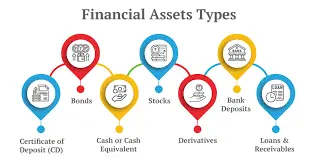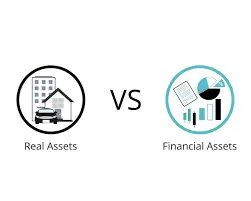lets first know what an Asset is. The term “asset” refers to something of value that can generate cash flows, unlike a “liability,” which creates financial obligations for the owner. However, owning an asset often requires some financial upkeep. The key point is that assets typically retain their value, except in extreme cases. Financial assets, though, can depreciate under certain conditions. This distinction will be elaborated on as we continue.
When we hear the word “asset,” real estate typically springs to mind. While real estate is certainly one of the most well-known real assets, many other items also qualify as assets. Therefore, assets can be either real or financial.

Table of Contents
ToggleUnderstanding Real Assets
Reall Assets are tangible and physically present. You can see and touch them, though they aren’t always portable. Their value stems from their inherent physical properties. For instance, real estate is a prime example of a reall asset.
Real estate encompasses land and all permanently attached properties. Therefore, structures such as buildings and industrial facilities are considered real properties. This also applies to lands utilized for agriculture and forestry. Real resources include natural resources such as minerals, oil, gas, timber, and precious metals like gold, diamonds, silver, and platinum. Additionally, infrastructures such as walkways, bridges, and public spaces are all categorized as reall assets.
Artworks and collections, including drawings, paintings, crafts, sculptures, antiques, and historical pieces, are considered real assets. Additionally, intellectual properties also fall under this category. However, it is crucial to understand that the term “real asset” refers to the physical manifestation of the idea, not the idea itself. Real assets in the realm of intellectual property primarily encompass trademarks, industrial designs, and copyrights that have been physically represented or expressed. Therefore, intellectual properties are categorized as real assets only when their physical representations are monetized through profitable sales.

Real assets are notably illiquid, meaning they tie up funds in a form that isn’t easily converted into cash. Consequently, financial interest in these assets takes longer to liquidate. Despite this, their value remains stable and typically grows with inflation, ensuring financial security.
Understanding Financial Asset
Finaincial assets derive their value not from their own inherent properties, but from contractual claims linked to either intangible or tangible assets. These assets are defined by their lack of physical form; they exist as representations or evidential documents rather than physical entities.
The anticipated cash flow and benefits from finiancial assets are forward-looking. The entitlements derived from these assets are not realized through physical possession (as there are no tangible assets involved), but rather through claims on the economic advantages they generate. Key examples of finiancial assets include shares, stocks, and bonds.
Shareholders of companies do not possess identifiable shares and stocks directly; instead, these are represented solely by share certificates that carry specific rights. The ownership of shares equals their par value, which is quantified and expressed as monetary sums.
Shares do not inherently rise in value with inflation, and this holds true for various other finiancial assets such as bonds and debentures. Bonds and debentures, categorized as finiancial assets, represent obligations a company owes to its creditors. These certificates serve as proof of debt and carry specific entitlements, including the right to repayment along with agreed-upon interest.
Commodities traded on exchanges are categorized as finiancial assets. Investing in stocks and other securities through mutual funds also qualifies as holding financail assets. Financial assets originate from contractual agreements that grant parties the future right to buy or sell securities or other contracted subjects on a specified date. Such agreements inherently constitute financiial assets.
Consider this rewritten statement:
An illustrative example includes a mortgage, which grants the holder the right to sell or foreclose upon the property used as collateral once the redemption date expires. Cash, cryptocurrencies, and other digital currencies also qualify as financiial assets. These assets derive their value from exchange rather than possessing intrinsic worth. Financiial assets are readily realizable in terms of economic value.

Differences
Based on the information discussed earlier, we can infer specific distinctions.
1. Tangibility: Real assets stand out due to their tangible nature, comprising physical forms such as buildings, land, equipment, and similar items.
However, financial assets fundamentally lack physical form. They exist solely through the rights and interests they confer, without any tangible claim to physical property.
2. Nature of value and claims: Real assets derive their value from their tangible and inherent characteristics. Unlike financial assets, which rely solely on anticipated cash flows in the future.
The value derives not from any physical property but from the rights and interests inherent in and accruing from the claim.
3. Liquidity: Real assets generally have lower liquidity rates compared to financial assets. Therefore, converting real assets into cash typically takes more time, whereas financial assets can be easily traded in liquid markets, quickly converting them into cash.
4. Risk of fluctuation: Real assets offer greater financial security compared to financial assets because they tend to retain their value in liquid markets, unlike financial assets which do not guarantee the same level of stability.
Real assets can experience significant fluctuations in value, yet they typically ensure long-term appreciation. In contrast, financial assets do not necessarily exhibit consistent value growth, despite their potential for appreciation. Moreover, financial assets frequently encounter market volatility. The financial system also faces risks of depreciation, especially concerning digital currencies.
5. Mode of returns: Financial assets generate returns through dividends, repayments, and interest payments, whereas real assets typically yield income from rentals, sales, and capital appreciation.
6. Ownership: Typically, real assets belong exclusively to their rightful owners. This entails direct ownership, management, and control over the asset.
However, when it comes to financial assets, although the owner possesses proprietary rights, they exercise management and control indirectly. The rightful owner only holds rights stemming from the asset, such as the entitlement to cash resulting from transactions involving their stake in the financial asset.
In Summary: Real assets and financial assets both generate income, in stark contrast to liabilities. Upon analysis, real assets emerge as more robust compared to financial assets. Their fundamental differences lie in their physical manifestation and potential worth.
Recommended:
